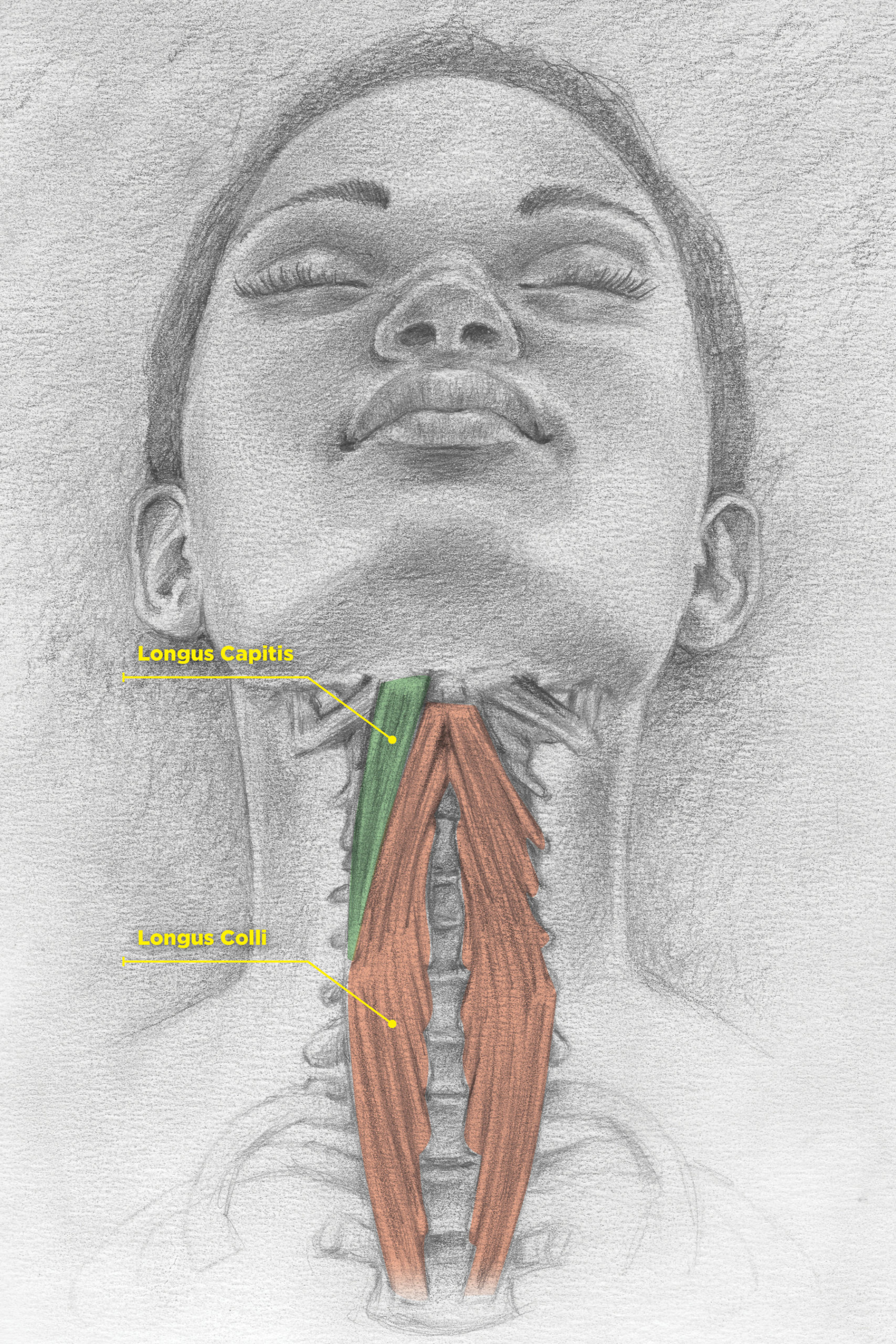Longus Colli and Capitis Muscles Can Help Your Headaches
If you suffer from headaches, the names of these muscles should be part of your vocabulary. Decrease your headaches by activating these muscles. These muscles are masterfully displayed in the illustration by artist Patrick McRae.
What Happens if the Longus Capitis and Longus Colli Muscles are Weak?
Weak longus capitis and colli muscle allow headache-producing muscles to become tight. As a result, these tight muscles can trigger your headaches. Major headache-generating muscles, such as the suboccipitals and sternocleidomastoid muscles can easily tighten. They tilt the neck upwards and push the head forwards.
How Can I Counteract these Tight Headache Muscles?
You need the longus and capitis muscles to have good control to keep the forward head posture at bay. Do not just strengthen these muscles. Build up endurance and control of the muscles because your head needs to stay upright for most of your day. Strong but easily fatigued longus colli and capitis muscles will not be up to the task of keeping your head upright all day long.
As a result, your head slips into the unsightly forward head posture. Your longus colli and capitis muscles keep your chin retracted into a good posture and help you to avoid a slumped posture.
How Do I Work the Longus Colli and Longus Capitis Muscles?
You can activate these muscles by putting your head and neck into better posture. There are several ways to activate them, several of which were discussed in the Suboccipital blog.
Firstly, you can place your head and neck into a good posture. Your 10-pound head gives enough weight to challenge these muscles. Remind yourself frequently to check if you maintained a straight, not slumped, posture. Secondly, you can place a theraband or scarf behind your head and pull the theraband or scarf forward to provide resistance while you keep your head in place. Thirdly, you can put a pillow behind your head and press gently into the pillow if the theraband is too much to manage. Finally, you can lie flat on your back as described by Gwendolen Jull and place your head against a blood pressure cuff. You then slowly increase the pressure that your head places on the cuff. This final method will give you the most control over your longus capitis and colli muscles.
Can These Exercises Help My Jaw Problem?
Yes. Some of my clients reduce their jaw clicking when they get into a better posture. Reposition your jaw by correcting your forward head posture. The slight repositioning may be just enough to decrease the clicking of your temporomandibular joint. You will require other techniques to treat your temporomandibular joint, but posture correction is a low-hanging fruit that is easy to do if it helps.
Does Activating These Muscles Always Get Rid of Headaches?
Some headaches respond to posture correction, others unfortunately do not. I like to think of exercise as medicine. You take medicine in the proper strength and frequency to get a positive result. If one medicine regimen does not work, it is adjusted to get the optimum benefit. A proper exercise program requires a similar calibrated dosage. A specific exercise may work spectacularly for one person’s headache, but not another’s. I find it most useful to help my clients when they can come to the headache clinic while their headache is present. We can then easily identify the problem and develop a corrective exercise program on the spot. Check with your friendly, neighborhood physical therapist to coach you in the best exercises for you!
-You understand that if not done properly, some techniques and exercises described in this blog could harm you. Any activities you perform are at your own risk, and you expressly agree to waive any claims against the author for any harm that may arise from your own actions. By reading this blog and conducting these exercises, you accept this risk. This blog provides content related to physical and/or mental health issues. As such, your use of techniques described acts as your acceptance of this disclaimer. Consult Chapter 2 in my book, “Calming the Headache Storm” to make sure the headache is not the sign of a more serious problem. The techniques, advice and strategies contained in this blog may not be suitable for every individual and should be abandoned if your headache increases. Seek the advice of your physician.
